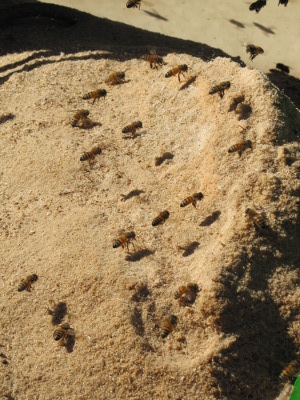
Bees gathering fungal spores from sawdust?
 Our
honeybees
were visiting my sawdust pile by the dozen yesterday, so I
decided to see if I could track down what they were up to. The
internet was not very helpful --- several people reported seeing
honeybees
visit sawdust in the early spring when there's nothing else around to
eat and they suggested that honeybees were collecting sawdust in lieu
of pollen. The sole piece of data backing up this assertion,
though, seemed to be the coincidence that pollen is absent in the wild
at this time of year and that this is the only season when people have
noticed honeybees collecting sawdust. While it's possible that
honeybees could be tricked into thinking that sawdust is pollen
(although at the bee scale, the two substances are orders of magnitude
different in size, shape and texture), I suspect that bees who expend
their precious winter energy on such a frivolous pursuit would die out
in the wild. Surely there's a better explanation.
Our
honeybees
were visiting my sawdust pile by the dozen yesterday, so I
decided to see if I could track down what they were up to. The
internet was not very helpful --- several people reported seeing
honeybees
visit sawdust in the early spring when there's nothing else around to
eat and they suggested that honeybees were collecting sawdust in lieu
of pollen. The sole piece of data backing up this assertion,
though, seemed to be the coincidence that pollen is absent in the wild
at this time of year and that this is the only season when people have
noticed honeybees collecting sawdust. While it's possible that
honeybees could be tricked into thinking that sawdust is pollen
(although at the bee scale, the two substances are orders of magnitude
different in size, shape and texture), I suspect that bees who expend
their precious winter energy on such a frivolous pursuit would die out
in the wild. Surely there's a better explanation.
Joey was visiting, and
he suggested that the bees might be extracting
some residual sap out of the sawdust. We reached down amid our
buzzing workers and snagged a pinch of sawdust apiece, then savored the
dust. At first, I couldn't taste anything at all, but after
Joey's more discerning palate caught a hint of nutmeg, I thought that I
might taste something too. No proof there, but it made for an
interesting photo.
As we continued to watch
the honeybees, I became relatively
convinced that they were putting something in their pollen baskets
rather than sucking the liquid out of the sawdust. I could see
the insects using their legs to push at their pollen baskets, and none
of the bees seemed to be sticking out their probosci. The
honeybees also seemed to be expending a lot of effort to kick through
the pollen in search of their desired object --- by midafternoon, the
pile of sawdust had turned from a volcano into a wide, squat
hill. Despite all this work, when I watched the bees returning to
the hive, I couldn't see any sawdust in the pollen baskets, suggesting
that the insects were collecting a much smaller substance than sawdust.
 Back
to the internet I went, this time delving into the scientific
literature. Several scientists repeated the pollen dearth
maladaption hypothesis, but none cited any sources. Instead, I
was drawn to a series of articles by Dorothy Shaw, who reviewed over
100 years worth of reports on bees collecting fungal spores all over
the world. Most of the bees gathered spores from rusts or Neurospora, both of which have a
protein content comparable to high quality pollen (around 25%).
Although in some cases bees seem to collect fungal spores when other
foods are absent, other bees fly right past good pollen and nectar
sources to gather fungal spores, returning to the hive with 100% spores
in their pollen baskets. Shaw suggests that the high protein
content of the spores makes them a nutrition source comparable to
pollen and that collecting spores can sometimes be a better use of a
bee's time than gathering pollen since large masses of fungi allow the
bees to fill their pollen baskets quite quickly.
Back
to the internet I went, this time delving into the scientific
literature. Several scientists repeated the pollen dearth
maladaption hypothesis, but none cited any sources. Instead, I
was drawn to a series of articles by Dorothy Shaw, who reviewed over
100 years worth of reports on bees collecting fungal spores all over
the world. Most of the bees gathered spores from rusts or Neurospora, both of which have a
protein content comparable to high quality pollen (around 25%).
Although in some cases bees seem to collect fungal spores when other
foods are absent, other bees fly right past good pollen and nectar
sources to gather fungal spores, returning to the hive with 100% spores
in their pollen baskets. Shaw suggests that the high protein
content of the spores makes them a nutrition source comparable to
pollen and that collecting spores can sometimes be a better use of a
bee's time than gathering pollen since large masses of fungi allow the
bees to fill their pollen baskets quite quickly.
I can't prove that our
bees are picking through the sawdust in search of fungal spores, but
I'm guessing that's the case. If they're gathering rust spores, I
might be able to test my hypothesis next time I look in the hive since
scientists have been able to pick out rust spores stored in the brood
chamber of honeybee hives by looking for their bright orange
color. I remember seeing bright orange "pollen" in our hives
before, and now I wonder if I was actually seeing spores?
Want more in-depth information? Browse through our books.
Or explore more posts by date or by subject.
About us: Anna Hess and Mark Hamilton spent over a decade living self-sufficiently in the mountains of Virginia before moving north to start over from scratch in the foothills of Ohio. They've experimented with permaculture, no-till gardening, trailersteading, home-based microbusinesses and much more, writing about their adventures in both blogs and books.
Want to be notified when new comments are posted on this page? Click on the RSS button after you add a comment to subscribe to the comment feed, or simply check the box beside "email replies to me" while writing your comment.

Great post - we were seeing the same behavior by our honeybees this week -- hundreds of bees visiting our sawdust stockpile. Yours seems the most likely explanation. Nice to benefit from all of your research on the subject! We are entering our 5th year of homesteading, looks like we're working on some similar projects....
Good luck to you and thanks again!
Milkweed --- interesting to hear that your bees were doing the same thing this week. I wonder if a specific fungus is sporing right now?
Zev --- thanks for commenting!
http://www.thewarrestore.com/benefitsofpropolis.htm
This website seems to think that they're gathering wood resin for propolis. . .